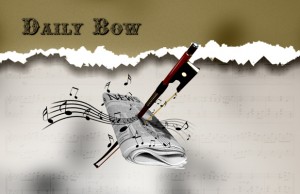 This week’s article on the ever-expanding Portland Cello Project brought the spotlight to a rapidly-expanding take on classical music: “indie-classical.” By now, we’re all familiar with indie films, pop music, photography–you name it, it’s been given the indie label. The classical music scene has long since abandoned the concert-hall mold for bolder, more ambitious, and more (but sometimes less) accessible formats, collaborating with artists of all stripes, appearing in venues of any nature, and performing music far outside the standard repertoire. As this phenomenon has been growing, though, there has been an implicit fear of the dreaded “crossover” label, which, as most musicians within the community realize, has a thoroughly negative connotation. Crossover artists are big news, too, with ABC’s hit show “Dancing with the Stars” featuring a “Classical Night” that bears little to no resemblance to real classical music–particularly in the quality of execution. Audiences love it, though, and the message in crossover’s popularity is loud and clear: change the typical classical music model, and audiences will come.
This week’s article on the ever-expanding Portland Cello Project brought the spotlight to a rapidly-expanding take on classical music: “indie-classical.” By now, we’re all familiar with indie films, pop music, photography–you name it, it’s been given the indie label. The classical music scene has long since abandoned the concert-hall mold for bolder, more ambitious, and more (but sometimes less) accessible formats, collaborating with artists of all stripes, appearing in venues of any nature, and performing music far outside the standard repertoire. As this phenomenon has been growing, though, there has been an implicit fear of the dreaded “crossover” label, which, as most musicians within the community realize, has a thoroughly negative connotation. Crossover artists are big news, too, with ABC’s hit show “Dancing with the Stars” featuring a “Classical Night” that bears little to no resemblance to real classical music–particularly in the quality of execution. Audiences love it, though, and the message in crossover’s popularity is loud and clear: change the typical classical music model, and audiences will come.
It is with this message in mind that a growing number of musical entrepreneurs have created a niche for themselves. Bay Area music publicist Maura Lafferty represents many such entrepreneurs, most of whom form ensembles that think outside the box while staying true to the high standards of musicianship and technical ability that true classical music demands. These groups, Lafferty says, represent the indie-classical movement, a label that has been applied largely to differentiate the level of playing in these groups as compared to the rampant crossover groups in the media. Lafferty herself, a conservatory-trained musician, is representative of the movement: her niche is that of conservatory-trained musicians who are open to a classical repertoire that may also include pop music covers performed to exacting standards, making full use of social media and often performing in alternative venues.
Two such indie-classical groups making the rounds now are Chicago’s Fifth House Ensemble (they have adopted the abbreviation 5HE) and L.A.’s 24-player chamber orchestra, wild Up. Fifth House Ensemble explores the art of story-telling with “narrative chamber music,” which typically takes the form of a graphic novel set to music, whether the setting be contemporary or standard repertoire. Lafferty says this is part of a “growing international trend to pair graphic novels & anime with classical music.” 5HE also created a work, In Transit, that explores social media themes and included the development of “digital personas…created and meticulously curated on Facebook and Twitter for the characters that are center to these tales.” As proponents of this new breed of classical entrepreneurship, Fifth House Ensemble has created a project entitled fresh inc, which takes the form of a chamber music festival that works with emerging musicians on such issues as managing one’s business, programming for different audiences and performing in varied venues.
In a similar indie-classical spirit, 24-member experimental classical/contemporary ensemble wild Up describes themselves as being “…committed to creating visceral, thought-provoking happenings.” Or, as Lafferty describes them, a “noisy new music hipster chamber orchestra.” Whatever the label, they are led by Artistic Director and Conductor Christopher Rountree. Their project “Ornithology” is one that typifies their ethos–it’s an evening about birds and flight that curates a program of music composed or inspired by Olivier Messien, Charlie Parker, and recorded birdsong. Connected on all social media, as is de rigeur for indie-classical artists, wild Up participated in Disquiet.com’s experiment in communal music making on SoundCloud Disquiet Junto. They also mounted a successful Kickstarter campaign for a vinyl release of their album, “The Salt of the Earth,” which is available for streaming or digital download via Bandcamp.
These two groups and hundreds like them across the globe are forging a new path for classical music while exploring new business models in the process. Their initial success is promising, and the groups have high hopes for reinvigorating–and thereby insuring the future of–classical music.














No comments yet.